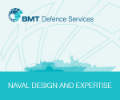BMT Defence Services Ltd has enhanced the design of its innovative Caimen-200 fast Landing Craft Tank (LCT) by improving its performance and increasing its detail, reliability, flexibility and ease of manufacture.
Caimen-200 is capable of achieving a transit speed of more than 16kn fully laden with up to three main battle tanks (MBT), this is virtually twice as fast as traditional fully flat bottomed LCT alternatives. The Caimen-200 therefore enables more weight and firepower of amphibious forces to be deployed in a shorter time and thereby greatly reducing the vulnerability to enemy fire. This results in greater overall effectiveness of deployed military resources.
The Caimen-200 employs a unique “active bow ramp” that utilises electro hydraulic rams to force the ramp into the beach, greatly minimising vessel pitch and roll. As part of the enhanced design activity BMT’s naval architects have examined in greater detail the forces experienced by Caimen-200’s active bow ramp under various loading conditions and states of tide.
This work has included collaborating with main battle tank operators to explore how they employ LCTs and how this may affect the performance of the Caimen-200. Additional loading information has also been used to refine the hydraulic system that powers the active ramp.
Other development activities have included assessing alternative power and propulsion systems. A Caimen-200e variant, for example, will offer a reduced top speed in order to reduce purchase cost and through-life fuel costs.
Nick Noel-Johnson, principal naval architect at BMT Defence Services and Caimen-200 project manager, said: “We wanted to develop the design’s maturity, mainly to enhance Caimen-200 itself but also to enable certain technologies included within its design.
“In the process of refining Caimen-200 we have overcome a number of new challenges. We’ve done this through teamwork, which is firmly embedded in BMT’s culture, and the application of technical excellence.”
Caimen-200 can be customised according to precise organisational and operational requirements. Clients can choose specifications and options in areas such as: shipbuilder and suppliers; vessel size; accommodation and facilities for crew and embarked troops; propulsion, power and exhaust systems; weapons systems; and communication equipment.

